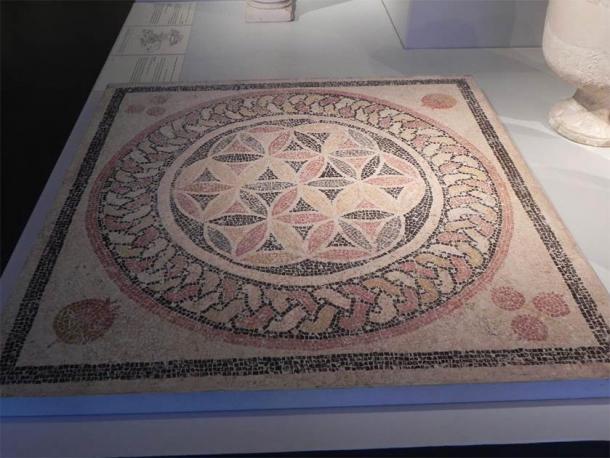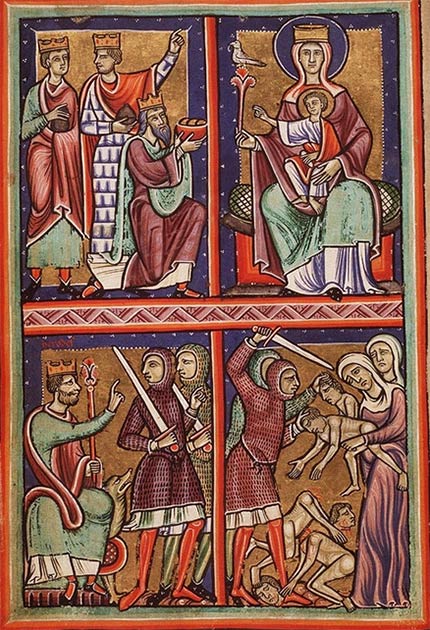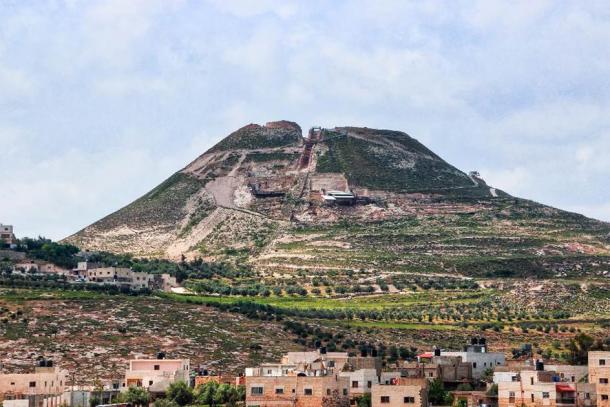Previously restricted sections of the lavish living quarters of one of history’s most infamous oppressors are about to be revealed to the public for the first time. On Sunday, Israel’s Nature and Parks Authority will be reopening Herodium , King Herod’s opulent fortress/palace complex, to tourists and other interested visitors.
The Marvels of Herodium, Updated
A popular tourist site, King Herod’s sprawling creation is perched high on top of a massive, cone-shaped artificial hill located in the Judaean Desert , 10 kilometers (six miles) south of Jerusalem. The combination fortified stronghold /grandiose palatial estate was built by contractors and slave labor at a strategic location well above ground level, giving Herod and his armed protectors an unobstructed view of the surrounding desert on all sides.

Aerial view of Herodium. ( Public Domain )
Tourists who come to the new and improved version of Herodium will now be able to visit Herod’s restored private hospitality room, the grand foyer where he hosted important guests like Marcus Agrippa, Caesar Augustus’s right-hand man, who visited the Judaean king in 15 BC. They will also be able to ascend Herod’s newly opened arched private stairway, and visit his formerly inaccessible private theater, where family, friends, and distinguished guests would gather to watch Greek plays and musical presentations, sponsored in the glorious name to Caesar Augustus, Herod’s beloved benefactor.
As visitors tour these architectural marvels, they’ll see expansive, colorful, and intricate mosaic floors, striped frescoes featuring marble-like patterns in vivid green, black, and auburn, and various other well-preserved wonders that pay testament to Herod’s architectural and artistic inclinations.

Section of mosaic floor unearthed at the Herodium. (ypav Dothan/ GNU Free Documentation License )
Where is Herod the Great Buried?
Herod built many similar fortresses in Judea, but Herodium was known to be his favorite. Per his request, he was buried at Herodium after succumbing to a long and painful illness. He ordered the entire palace complex on top of the hill to be covered with earth, to avoid overshadowing his eternal resting place, which he undoubtedly expected to become a shrine visited by flocks of admirers each year.
In fact, Herod’s grave was never viewed as a shrine by anyone, and likely had few visitors outside of the vandals who broke into his sarcophagus and stole his remains. Forgotten and forlorn, archaeologists only discovered his tomb in 2007, well after excavations had begun at Herodium in 1962.

Ruins of Herodium. ( Eitan Ya’aran )
While Herod’s decision to bury his palace may have been motivated by vainglory, his actions helped protect Herodium from the erosive forces of the wind, sun, and rain, which could have turned much of the complex into unrecognizable rubble. Archaeologists who unearthed the palace over the course of decades marveled at how well-preserved everything was and how pristine both the interior and exterior had remained, despite the passage of more than two millennia in a desert environment.
“This is an unparalleled architectural laboratory,” Hebrew University archaeologist Roi Porat, who leads the excavation and restoration activity at Herodium, told the Daily Mail , comparing the palace complex to the perfectly preserved lava-covered site at Pompeii.
Speaking of Herod, Porat acknowledges that “his name has been preserved here,” which historians agree was the type of recognition he craved.
Herod the Great and the Tyranny of Hate
Herod ruled as the Roman-appointed king of Judea from 37 BC to 4 BC. Herod’s style of government was brutal and repressive, especially toward the end of his term. But his fondness for grand and expansive building projects reshaped the landscape around Jerusalem and left a legacy in stone that has stood the test of time.
Like all ambitious infrastructure projects, Herod’s adventures in monumental architecture and construction created many jobs and pumped a lot of money into the local economy. Nevertheless, he was hated by the Jewish people over whom he ruled, who viewed him as a symbol of the oppressive and burdensome policies of the Roman Empire he represented. While most historians confine the story of Herod’s Massacre of the Innocents to the realm of myth, there is little doubt that Herod’s methods of rule were harsh and violent and did nothing to endear him to the indigenous inhabitants of Judea.
Herod’s preoccupation with building monuments to his greatness finds a disturbing echo in the career of Adolf Hitler. This reveals much about the megalomaniacal mindset that drove his actions, as an architectural patron and an authoritarian king who ruled with an iron fist.

The massacre of the Innocents: Herod orders his men to go to Bethlehem. ( Public Domain )
A King with Monumental Insecurities
Tourists who come to Herodium are visiting a location that by all accounts meant more to Herod than any other place he built. What they see reveals his personal preferences in art and architecture, but it also reveals something even more important, which is the nature and depth of Herod’s insecurities.
Built at an unapproachable elevation, surrounded by a small hillside village occupied by soldiers, functionaries, and sycophants, in the middle of the desert enclosed by an empty and easily surveyed landscape, Herodium reflects its overlord’s deep-seated fears of revolt, invasion, and assassination. Whether he was willing to admit it to himself or anyone else, Herod clearly knew how the people of Judea felt about him. Herodium was constructed as a buffer, to keep Herod safe and secure from the consequences of his harsh and unyielding rule .

Ruins of Herodium (Herodion) Fortress of Herod the Great, Judaean Desert near to Jerusalem, Israel. ( svarshik /Adobe Stock)
Herodium is a testament to humanity’s capacity for remarkable artistic vision and achievement. But it’s also a monument to the impact of tyranny, and the sense of profound distrust and disconnection from the populace it creates. In reality, Herod feared his subjects just as deeply as they feared him, and with good reason.
Top image: New sections of Herodium, King Herod’s palace, are opening to visitors. Source: Kushch Dmitry /Adobe Stock
By Nathan Falde
 RSS Feed
RSS Feed















 December 12th, 2020
December 12th, 2020  Awake Goy
Awake Goy  Posted in
Posted in  Tags:
Tags: 













